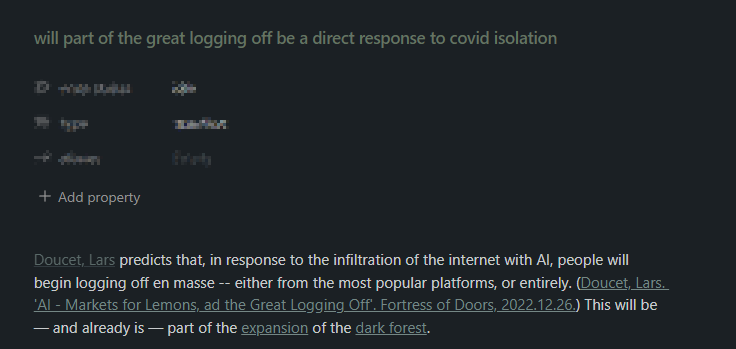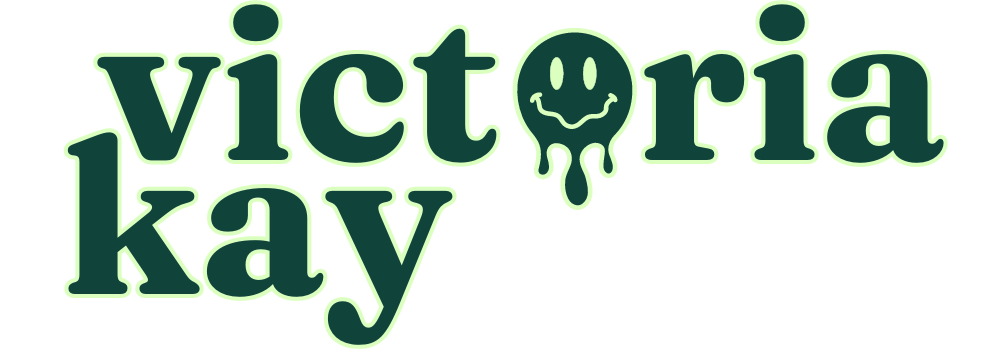Personal Knowledge Management is the Path to Innovation

Implementing a Personal Knowledge Management practice has been the most impactful thing I've done in... Ever. It's completely changed the way I think, let alone the way I work, and as I've continued to iterate and work within my system, the more convinced I am that this is the root of innovation -- especially for businesses our size.
If you're not familiar, Personal Knowledge Management ("PKM") is essentially the practice of organizing all of the information in your world: the media you consume, your thoughts about and reactions to that media, and the ideas that are generated as you start combining insights from multiple sources.
It's strange to me that there isn't more overlap between PKM and the online business world. There does seem to be some overlap in the community -- I think both tend to attract bootstrappy, DIY, lifelong-learner types -- but there's very little overlap in content.
While there are plenty of templates out there for organizing courses, blog posts, and bookmarks for your business, I don't see many people talking about using that information after you've purchased / downloaded / finished it.
Let's start bridging that gap.
But first, two notes:
Personal vs. Business Knowledge Management
I will still be referring to this as "Personal Knowledge Management for Business" instead of "Business Knowledge Management".
Coming from a systems and processes background, BKM to me is your intellectual property. It's the processes, products, and content you've created to help your clients and customers achieve a certain result.
PKM, on the other hand, is a tool for thinking. While it's great for innovation, it isn't the developed product the way BKM might be.
WTF is a "note"?
My notes are made up of three components: a title that communicates one idea, a body that provides context, and a source (or multiple) for where the information is coming from.
A note in my system is one page, regardless of what tool I'm working in -- this has been true in Notion, Obsidian, and, currently, Capacities. In each piece of software, one note = one page = one idea.
This is often referred to as "atomic notes", which we'll review in a bit.
Your notes may look completely different depending on your workstyle, tools, and systems. A note might be a Google Doc or an index card or a bullet point; it doesn't matter where you put them or in what format, as long as they're easy to access and search.
The Three Pillars of PKM
Note-Making is the active process of identifying key themes and ideas and communicating them in your own words.
This is different from note-taking, which tends to be a passive process of regurgitating whatever the speaker / author / creator says is important. In note-making, you identify what is important to you and rephrase it in your own words.
That might sound like a distinction without a difference if these are new terms to you, but think of it like this: In note-taking, you pull out ideas that are related to the content; in note-making, you pull out ideas that are related to your interests and the things you want to study.
When reading this article, the two different styles of notes might look like this:

One isn't necessarily better than the other, but this shows how note-making allows you to mold and communicate ideas in a more impactful way than just summarizing what I've written in this post.
If you want to see someone else's ideas, you can just go back to the original content! In PKM, the goal is to document and build on your own ideas that come up as a result of the content you're consuming.
Atomic notes are more flexible than running notes.
Note-making becomes even more powerful when your notes are atomic. This means that each note holds one idea (or concept or question).
Remember my system? One note = one page = one idea. This is why.
Imagine you're back in school – or, more specifically, imagine you're U.S high school student in the middle of an American History class. You're talking about smallpox, and you remember that you had to read a bunch about smallpox in last year's World History class.
You go digging for your World History notes. There are pages for different chapters or class periods or eras in history, and your notes about smallpox are spread throughout all of them.
What if, instead, you could click a button and every note you've created about smallpox pops up like this:

Now you can see all the major ideas you've noted about smallpox, from its origin to the history of inoculation all the way up to George Washington.
This is the power of atomic notes: the ability to surface self-contained thoughts and ideas about a given topic from any context.
As another example, let's look at my own notes about artificial intelligence.
In traditional note-taking, I might have one long document with my AI notes. Or they might be scattered across all the different sources I've used to collect information on AI; my notes from an article about AI and art would be separate from my notes on an article about AI in politics, and so on.
There's not anything wrong with that, but with atomic notes, I can easily search for and see individual ideas about AI, regardless of where they came from. This allows me to have notes like:
- AI prompts are just context (written after reading this article, which has my favorite slug of all time: /thoughts/boo-chatbots, lol)
- artificial intelligence can never replace the human experience (written after reading this Nick Cave newsletter)
- will part of the great logging off be a direct response to covid isolation (written after reading this article, which I mentioned in a previous post)
(These note titles may not mean anything outside the context of my system, but trust me that I know exactly what I'm communicating!)
Each of these thoughts -- written over a period of months, inspired by different sources, and covering different topics -- exists as a standalone note that can be referenced and used in any other writing across my entire PKM system.
Which leads us to the second key principle of PKM: thought linking.
Densely linking your notes allows you to make connections between seemingly-disparate concepts.
A lot of online business owners are familiar with the idea of linking data. In Notion, for example, you might link your Projects database to your Clients database which might be linked to a People database, and so on.
This is a fantastic way to attach more context to your work; it expands on what you're doing to explain why and for whom.
But what about linking your thoughts? How do you continue to build context around your ideas?
I think I first heard about this concept when I read about digital gardens. (I'm going to pause here to tell you that you must bookmark this article by Maggie Appleton to read later. It's one of the best places to start and has fundamentally altered how I exist online. Not an exaggeration!!!)
In a "digital garden", instead of having static navigation -- Home, Shop, Blog, etc. -- most navigation happens within the body of a given text. There is some navigational structure, but the user is able to click through contextual links, meandering through different (but connected) topics at their will.
Check out this GIF of me navigating one of my favorite digital gardens (Andy Matuschak's Working Notes):

I start with his page about why notes should be atomic and end up all the way at a concept called Constructivism just through reading and clicking on the ideas that sound interesting to me.
I don't have to stop and go back to his blog page, I don't reach the end of a page and feel like I'm "done"; it keeps me engaged, and it keeps me learning.
But, perhaps more importantly, it allows the note-maker (Andy, in this case) to connect all the different topics, concepts, ideas, and sources to each other freely.
This is how my PKM system works, too; while I do still link notes to a database of topics (I call them "Domains") to easily filter and query my notes, the majority of my navigation comes from in-text, bidirectional linking.
Remember my note on "the great logging off"? Here's what that the beginning of that note actually looks like:

Using bidirectional links, from within this note I can access (1) my note on Lars, the writer who inspired the note, which will show me all the other articles by him that I've saved, and (2) my note on the source material so I can revisit a summary of the article, my initial reflections, and other notes I created as a result of it.
But there are two more links: "expansion" and "dark forest".
If I click the former, I'm taken to a source note for an article that gives a name to the phenomenon Lars predicts. There are more notes linked here so I can continue navigating through my system:

Or, if I click the latter (the "dark forest" link), I'm taken to yet another note that links to more notes so I can keep navigating through my notes:

Do you see how this works?
It means that I can start effectively anyyyyyywhere in my notes and click link after link after link through my ideas, the articles I've read, the questions I'm exploring.
Linked thinking is expansive thinking.
Again, I'm pulling from Andy here, who beautifully captures why linking your notes is so beneficial. He raises a few points in one of his own notes:
- If we're intentionally linking between notes, we're encouraged to think about how different topics and ideas relate to each other;
- By being mindful of and searching our notes for possible connections, we're organically reviewing our material for better comprehension and memorization;
- When our notes are linked together, we create a paper trail of how we reached our conclusions.
In other words, when you build the practice of linking notes, you build the practice of linking your thoughts for bigger, better, more complete thoughts.
You no longer see "marketing", for example, as a standalone area of business; you start to see it connected to your behavior on the web as a whole, connected to cultural changes like the growth of AI, connected to technological advancements and regulation changes.
And by densely linking your notes around these ideas, you get a far greater understanding of each individual piece. As a result, you often get what Anne-Laure Le Cunff refers to as "idea sex".
Idea sex is the process of combining multiple thoughts to generate new ideas.
To be clear, Anne-Laure is not the person who coined the term idea sex, but once I read it on her site, I couldn't stop saying it.
It perfectly captures what happens when you start using and navigating linked, atomic notes: your ideas come together to mate and produce weird, new, hyper-personalized offspring.
I actually didn't start a PKM practice with the intention of generating ideas; I just wanted a better way to save all the articles I found myself recommending to people. I casually started taking notes and, once I moved into Obsidian, naturally started linking them.
Idea generation happened organically. It's an accidental, serendipitous byproduct of thinking and writing more. I don't even have to put conscious effort into it half the time; ideas naturally occur to you as you create space in your mind and a framework for more intentional and connected thinking.
For example, I've mentioned that I wanted to bring back the webring. The webring isn't new, and neither is a desire to have a resurgence.
What is new is how I'm reimagining the concept for micro-businesses.
And I didn't arrive at that reimagining by sitting down and going, "Okay, brain, I don't like the internet or business right now; what can I do to change it?"
I arrived there by working with my first client years ago, who did a podcast episode with Amy Hoy; doing research for show notes, I found Amy's popular article 'How the Blog Broke the Web'.
From there, I read about digital gardening, found the indieweb, explored the Dark Forest and the Extended Internet Universe.
Trying to figure out my own approach to the indieweb, I read a paper about LiveJournal from 2005 (which talks quite a bit about webrings), which made me look for old geocities sites, which led me to Neocities, which led me to sadgrl.online's webring directory, which made me revisit the indieweb principles, which led me to Max Böck, who HAS A WEBRING KIT!!!!!!!!!
It's a simple idea, sure, but it's been years in the making, mostly on accident.
Sometimes this process has been active, like when I've researched how to add webmentions to Wordpress. But sometimes it's been entirely passive; I wasn't thinking about business when reading about how AI is expanding the dark forest, or when I was trying to save GIFs from Cameron's World.
I didn't sit down with a pen and a piece of paper and brainstorm this.
It happened organically as a result of how I was already approaching the way I learn and think.
My mind did all the hard work in the background while I sat here with my cup of tea and click-clacked away on my keyboard.

Meanwhile, I can trace the entire process back years and I continue to make new connections, including earlier today while writing this piece.
That is the power of Personal Knowledge Management.
Why isn't the business world more ingrained in the PKM space?
Okay, I've said all of that to reach this point: PKM, this cycle of information, is how we innovate.
I feel like we've been fed this lie that time spent on activities like this is a waste of our time. We should be working on our business, we should be copying what works, following the 80/20 rule, etc. etc.
But, like... Why?
Why is it more important for us to grow vertically and scale rapidly than it is for us to create and share new perspectives? Why do we stillllllll prioritize the hustle over the imagination?
(My theory, frankly, is that this is a combination of status-quo reinforcement and the fact that min/max bros just happen to be the loudest online. If we start thinking and working differently, so will others, and that will break the culture of rapid-scale, etc. – but that's an article / soapbox for later.)
I think this is especially interesting when you consider how much of the biz space is educational products! How much money have you spent on courses, trainings, and webinars??? And, uh, how much do you remember about each of them?
We are consuming, but we aren't absorbing.
And, not to be that guy, but maybe that's making us a little too forgiving of people charging $$$ for courses that aren't worth taking notes on 👀
So, if you want to change that, if you want to start taking a different approach to how you learn and think about business, here are some suggestions:
- Find yourself a bookmarking / read-it-later app. I currently use Raindrop for RIL and MyMind for bookmarks, but I also like Omnivore and Readwise Reader. Start clipping articles, courses, training, etc. into them. This is your media inbox.
- Create a database, folder, or physical location to store your notes.
- Try creating atomic notes the next time you read an article or newsletter, or the next time you're working through a course. Don't overthink it; you don't need a ton of fields or metadata yet. Just take notes. See if you can find connections between them besides what the author / creator is communicating.
I hope to expand on these thoughts a bit more later, to really rethink what PKM looks like for business. But, for now, try this process and see how it feels. See whether it clicks in your brain. And let me know! I want to hear what you think.
Two housekeeping notes:
First, if you read the journaling article I posted last week, I'll be following up on that in a different space. I loved writing it, and felt like I needed to, but this isn't the right venue. I already knew I wanted a separate space for writing about journals / life archiving, but was worried I was overcomplicating things. I'm 99% sure now that I'm not; this is the right call. If those topics interest you, you can checkout my other newsletter at narrativebynature.co.
Second, I could use your input on something. I think I'm ditching the paid newsletter idea for now. I can't quite figure out how to make it make sense with my existing writing without paywalling information that I want to be free. I have some product ideas, but those will take a while to flesh out and get published when I have so many articles on deck to complete 🫣 And the biggest of those projects (webrings / cozyweb / indieweb biz platform??) will also be $Free.99.
Judging by the responses I've gotten via email, people are connecting with some of these ideas, and I want to be able to lean into this as much as possible. So, I'm just gonna ask: Is there anything specific that would make it a no-brainer for you to support my writing?
Do you want a paid newsletter, just in a different format? Would you prefer something 1:1 (I'm considering offering paid brainstorming sessions)? Should I just get my product library up ASAP? Affiliate marketing?? Some other membership or a Patreon style thing???
Please drop a comment or email me at hello@victoriakay.co if you have thoughts!
In the meantime, I've set up a Buy Me a Coffee page, with donations starting at $2. I honestly -- sigh – feel kind of weird about this, but it's something I actively use to support creators I follow, so maybe you'd like it as an option too? I figure it can't hurt to test it for a couple weeks :)
I hope you enjoyed this piece. Some of these thoughts have been rattling around in my brain for a while, and I can't wait to keep expanding.
If it resonated, I'd love to hear your thoughts!
Talk soon,
V

Member discussion